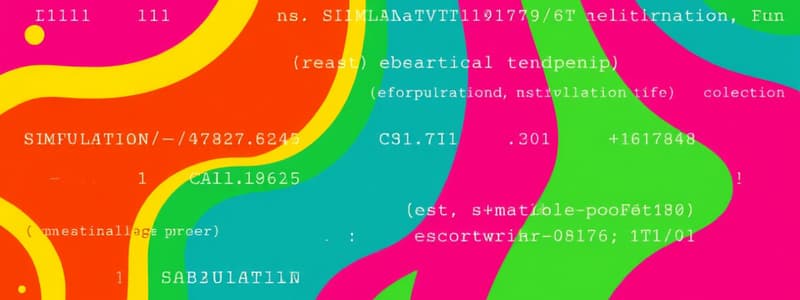Podcast
Questions and Answers
What is the primary focus of steady-state performance?
What is the primary focus of steady-state performance?
- Analyzing transient states
- Identifying initialization errors
- Ensuring model outputs are accurate
- Evaluating system behavior after long runs (correct)
What type of model allows the state variables to have an infinite number of values?
What type of model allows the state variables to have an infinite number of values?
- Probabilistic model
- Deterministic model
- Continuous-state model (correct)
- Discrete-state model
Which method is NOT used for transient removal?
Which method is NOT used for transient removal?
- Moving average of independent replications
- Truncation
- Quick sampling techniques (correct)
- Proper initialization
Which of the following is a necessary aspect to validate in model validation techniques?
Which of the following is a necessary aspect to validate in model validation techniques?
How is a discrete-time model characterized?
How is a discrete-time model characterized?
What does the term 'degeneracy tests' refer to in model verification?
What does the term 'degeneracy tests' refer to in model verification?
Which issue arises from models not representing the real system accurately?
Which issue arises from models not representing the real system accurately?
Which model allows for different outcomes when the same input is repeated?
Which model allows for different outcomes when the same input is repeated?
Which technique specifically ignores initial data to measure variability in steady-state?
Which technique specifically ignores initial data to measure variability in steady-state?
What is a primary advantage of trace-driven simulation?
What is a primary advantage of trace-driven simulation?
What is the outcome of performing a continuity test during model verification?
What is the outcome of performing a continuity test during model verification?
What does a 'trace' refer to in the context of trace-driven simulation?
What does a 'trace' refer to in the context of trace-driven simulation?
Which of the following is an example of a continuous-time model?
Which of the following is an example of a continuous-time model?
What represents a change in the system state in simulation terminology?
What represents a change in the system state in simulation terminology?
Which of the following is NOT an aspect validated in model validation techniques?
Which of the following is NOT an aspect validated in model validation techniques?
What does 'open model' refer to in the context of simulation?
What does 'open model' refer to in the context of simulation?
What does it mean for a model to be 'stable'?
What does it mean for a model to be 'stable'?
What is a notable disadvantage of using trace-driven simulation?
What is a notable disadvantage of using trace-driven simulation?
When performing truncation, what is a key factor to observe?
When performing truncation, what is a key factor to observe?
Which of the following is NOT a characteristic of trace-driven simulation?
Which of the following is NOT a characteristic of trace-driven simulation?
What is a typical input for trace-driven simulation?
What is a typical input for trace-driven simulation?
In trace-driven simulation, what is the role of the trace?
In trace-driven simulation, what is the role of the trace?
Why might trace-driven simulation be considered a single point of validation?
Why might trace-driven simulation be considered a single point of validation?
What makes trace-driven simulation credible?
What makes trace-driven simulation credible?
Flashcards are hidden until you start studying
Study Notes
Programming Language Selection
- Simulation languages are specialized for modeling and can be extensions of general-purpose languages.
- Extensions serve as collections of routines to manage common simulation tasks.
- Simulation packages often face inflexibility challenges.
Types of Simulation
- Emulation: Involves replicating an environment using hardware or firmware; examples include terminal and processor emulators.
- Monte Carlo Simulation: A static simulation technique without a time axis that models probabilities and evaluates non-probabilistic expressions.
- Trace-driven Simulation: Utilizes time-ordered event records from real systems, offering advantages like credibility and validation, but suffers from complexity and single validation points.
- Discrete-event Simulation: Comprises various components such as event scheduler, simulation clock, system state variables, and routines for data handling.
Analysis of Simulation Results
- Important techniques include model verification, model validation, transient removal, and establishing stopping criteria.
Model Verification Techniques
- Employs a top-down modular design, anti-bugging practices, structured walk-throughs, and deterministic models.
- Uses simplified test cases, graphic displays, and continuity tests to ensure model accuracy.
- Includes degeneracy and consistency tests, along with seed independence checks.
Model Validation Techniques
- Validates assumptions, input parameters, and output conclusions against expert intuition, real system measurements, or theoretical results.
Transient Removal
- Focuses on achieving steady-state performance by identifying and removing transient states using methods like long runs, proper initialization, and deletion of initial data.
- Truncation ensures that variability is less during steady-state than in the transient phase, employing techniques to ignore initial observations until stable states are identified.
Common Mistakes in Simulation
- Common errors include inappropriate detail, using improper implementation languages, unverified or invalid models, and mishandling of initial conditions.
- Additional mistakes encompass overly short simulations, poor random number generators, and improper seed selection.
Terminology
- State Variables: Define the system's state (e.g., job queue length in simulations).
- Event: Represents a change in the system's state, with models categorized as continuous-time or discrete-time based on state definition.
- Continuous vs Discrete: Continuous models allow states defined at all times, while discrete models define states at specific time intervals.
- Deterministic vs Probabilistic Models: Deterministic models predict outputs with certainty, while probabilistic models yield different results upon repetition with the same inputs.
- Static vs Dynamic Models: Static models have fixed states, while dynamic models change over time.
- Open vs Closed Models: Open models receive external input, whereas closed models operate independently of external inputs.
- Stable vs Unstable Models: Stable models reach a steady state regardless of time, while unstable models do not.
Studying That Suits You
Use AI to generate personalized quizzes and flashcards to suit your learning preferences.




